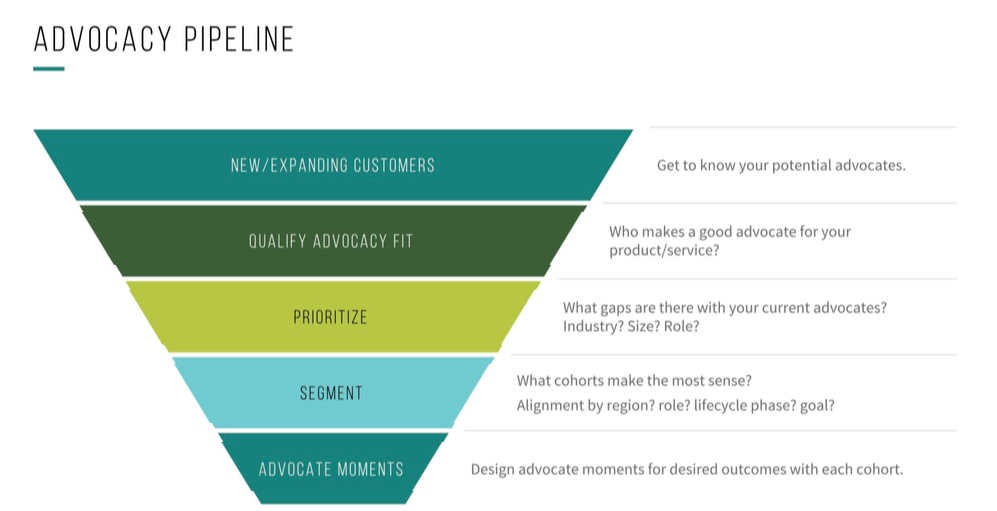Tell me if this sounds familiar: You get a request for a reference, guest speaker, or success story. You scan your list, realize it’s incomplete, and jog over to your customer success team to ask, “Hey, know anyone who’d be a great fit?”

If that’s you, you’re limiting the quality and diversity of your advocates, according to Ellie Wu, Senior Director of Customer Experience Transformation at SAP Concur. In her talk at Advocamp last year, Ellie discussed why brands need a process for identifying who their top brand champions are.
“If you apply structure, it starts to look more like a sales pipeline,” says Ellie. “I call it an advocacy pipeline.”
A pipeline helps Ellie and her team nurture more customer advocates (and more avid ones) by reaching them right at the start of their journey—before they’re set in their ways and reluctant to try something new, like be a reference.
With a few minor changes, you too can foster strong advocates and produce the right references, content, and customer community to help your sellers sell, marketers market, and business boom.
In this article we’ll explain Ellie’s process for constructing an advocacy pipeline in three stages. You can watch Ellie’s full talk here by registering for the limited free access trial of Advocamp On Demand.
Stage 1: Build a repeatable process for activating the right advocates
The first change you can make is to be more proactive. Rather than wait for volunteers, assess new and expanding customers for advocate potential right at the start of their journey. Select those who would make the best brand champions and reach out.
Ellie recommends identifying those people in four steps:
1. Study your advocates
Before you fire off any emails, you have to know who your customers are and what makes them tick. Ask yourself: What sort of community are you looking to create? What’s in it for users? How can you get them to help each other?
For instance, do customers prefer tangible rewards such as swag and gift cards, or do they want to be praised on LinkedIn? Would they prefer to join a discussion group with industry peers or play an online Mad Lib style game of the sort that software firm Quick Base offers?
There’s no need to guess. Ask customers and advocates what they want by using:
- Surveys
- Community discussions
- One-on-one interviews
Spark conversations between advocates in a discussion forum, if you have one, by asking quirky questions that show off your brand’s personality. This creates space for them to relax and share more of themselves as well. Whenever you can, listen in on customer kickoff calls.
Whatever program purpose you land on, write it down. That’s your outcome, and you should design your entire process around it.
2. Qualify customers for fit
While all customers can be helpful, some are more valuable at a given time than others, either by dint of their role, proponency to share, or vertical. And as fun as it would be, you can’t spend all your days grooming everyone.
Write down criteria for what makes a strong champion. “I ask, who makes sense for us to nurture? Who’s going to be that next great success story?” says Ellie. “I like to be very clear on who I’m looking for.”
3. Prioritize your content needs
Let your company’s content needs guide your program. Ask your sales, customer success, and product teams what’s on the roadmap and what types of customer stories they’ll need in the next year.
Are there any gaps in your content? Are you missing any stories from a certain customer persona? Perhaps there’s a specific industry your sales team wants a case study for, or a vertical the marketing team wants to address. Write all that down.
4. Segment potential advocates
Finally, it’s time to get ultra-specific. Divide your potential advocates into segments based on vertical, region, company size, lifecycle stage, role, or whatever makes the most sense for your business. Select ones who can fill your content gaps.
Double-check that there’s cohesion to your choices—are there enough people with overlapping interests to form micro-communities within your community? Will your program incentives inspire them all? If the answer is yes, it’s time to reach out.
But, as any good advocate marketer knows, outreach demands tact. To form durable relationships, you have to listen to their pain points and strive to give them the best possible experience.
Stage 2: Eradicate points of friction in your customer journey
After you’ve identified which advocates to target, add some structure to the way you nurture them. Every touchpoint in your pipeline matters, and affects the odds that they’ll become brand champions.
“A customer’s willingness to advocate is the cumulative result of how they felt at every moment with every team,” says Ellie. “You have to design each moment to reinforce the outcomes you want.”
Not every aspect of the customer experience is under your control. But to design those moments as best you can, you have to understand their experience from sale to renewal. Ellie recommends the following five steps:
1. Ask potential advocates about their experience with sales and services
In most cases, your customer’s first interaction is with sales. Understand what that process was like for them by asking four questions after the sale is complete:
- What do you wish we would have done?
- What do you wish we would stop doing?
- Which parts of your experience did you enjoy the most?
- Which parts did you enjoy the least?
“First impressions matter, and you want to get off on the right foot,” says Ellie. “Make sure the sales team is setting the stage for you.” The happier your sales process makes customers, the easier it is to ask them to advocate for you. Work with your sales team to make needed improvements.
Next, examine customers’ interactions with your services team. “New customers often start on a high thinking about all that’s possible, but then comes implementation. How do they feel? Are they getting buyer’s remorse?” asks Ellie. “You have to help them through any hesitation or anxiety.”
Involve your user research group, if you have one. These folks can help you understand why customers approach a product or problem the way they do, and understand whether issues are due to training, expectations, or product (many of which are fixable).
Always be on the lookout for customers who are willing to be radically candid, and you should be equally honest back. It establishes transparency and gives you the insight you need to improve the system.
2. Challenge your customer success team to exceed expectations
Customer success managers are no strangers to customer advocates. But to help with recruitment, success managers need to do more than make customers happy.
“You have to ask, ‘What’s the optimal customer success experience? How do customers find it most helpful to work with us?’” says Ellie. “Find the advocates who can answer those questions, and deliver on their needs.”
Use what you learn to design each support moment to lead to advocacy. Support managers must go beyond making customers’ lives easier and provide meaningful help that exceeds expectations. And at that moment of peak satisfaction, support managers need to ask customers to become advocates.
3. Use advocates to support other customers
Customer service doesn’t have to come exclusively from your team. You can create a path for expert customers to add their insights to your customer knowledge base, or respond to questions on forums or social media, fostering an interactive support community.
Create a system for recognizing advocates when they contribute. Give back through awards, shout outs, and points, and do all you can to incentivize that behavior.
4. Ask customers to advocate for you
Next, advocates fall into the marketing team’s hands. Think about your efforts here as they relate to your needs and content gaps. Engage the advocates who can help you fill those needs, and ask them for acts of advocacy.
Make sure that advocating is easy, and that they’re likely to do it again. After acts of advocacy, ask customers:
- What was it like to advocate?
- Did you get what you needed out of it?
- What would you change?
5. Connect your product team with your advocates to help the company stay relevant
Involving advocates in product development helps you stay relevant by ensuring your product meets buyers’ changing desires. Being relevant, says Ellie, is how you’re going to build products that continue to delight customers.
“One of the most insightful exercises I’ve conducted with a User Research team was inviting customers to a roadmap discussion and handing them Monopoly money,” says Ellie. “We asked them to take their limited resources and make bets on our roadmap, giving us insight into why they prioritized things. It was fun, but it helped them solve some of their own problems, and taught us a lot.”
Once your advocacy pipeline is built and you’ve buffed all the friction out of it, you can afford to step back and ask, “Who other than customers should be advocating for us?” And for that, Ellie has two answers.

Stage 3: Get your non-customer fans engaged and involved
When it comes to day one advocacy, there are two other groups who are also vital champions: non-customers and employees.
People who have never purchased from you may already be rooting for you and talking up your product at events or with colleagues. Chances are, they know people who are evaluating your product or service, and can sway their decision and long-term impression of your company.
And then there are your employee advocates. Nobody is better qualified to speak to your company’s vibrant, customer-first culture, since they live it every day at work. Get employees talking on social media about why they chose to work at the company and why they’re excited about new developments.
Encourage non-customers and employees to advocate, and you can speed more happy customers through their journey. More customers means more potential brand champions, and more great fits for your team’s content gaps.
As you go forth to apply Ellie’s day one advocacy strategy to your own program, we’ll leave you with three takeaways from Ellie’s session:
1. Stop waiting for volunteers to advocate
You can’t sit back and expect advocacy to happen. Identify, qualify, and nurture those future champions. Design a path to advocacy that’s friction-free and meets both you and your customers’ goals.
2. Advocacy is a team sport your entire company must play
Make sure your whole company participates in advocacy initiatives and that each team owns its customer moments.
3. Be the means to your customers’ ends
Last but not least, remember what you are there to do: provide a product that alleviates your customer’s pain. The strongest advocates start as satisfied users, and if the entire company understands that, you’re well on your way to enlisting the best champions right at the moment when you’re most likely to win them over: day one.












































